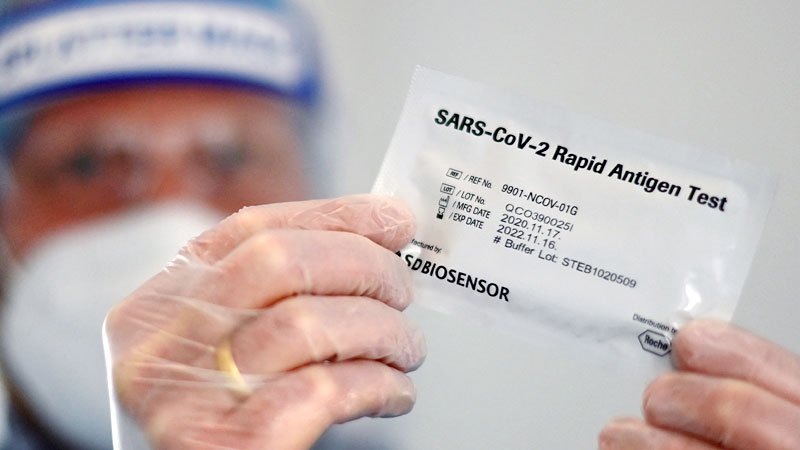The reverse-transcription polymerase chain reaction (RT-PCR) test has been the gold standard for the diagnosis of COVID-19 throughout the pandemic. This highly sensitive molecular test amplifies specific segments of the transcribed viral DNA collected in a sample. Specialized labs can usually provide results in 12 to 24 hours.
In contrast, rapid point-of-care antigen tests for COVID-19, which have been on the market since the middle of 2020 and can be performed anywhere, can return results in minutes by way of a test strip housed in a cassette of these lateral-flow immunochromatographic assays that detects viral proteins.
Rapid tests are about 1000 times less sensitive than molecular tests, but sensitivity is not the only consideration when deciding which test is most appropriate. Cost, availability, accessibility, and how quickly the results are needed should also be considered.
In the European Union (EU), COVID-19 rapid tests designed for use by healthcare professionals are classified as general in vitro diagnostic devices, and must bear the Conformitè Europëenne (CE) mark, which means that the manufacturer declares that the product meets the safety, health, and environmental protection requirements of the EU. These tests can be obtained only by certain groups, usually healthcare workers.
Tests designed for use by the general public are classified as self-testing devices and, in addition to the CE mark, the manufacturer must obtain a declaration of conformity from an organization designated by an EU country, known as a notified body, that confirms that the product meets all requirements. The CE marking on these tests is accompanied by the identification number of the notified body. Self-testing kits are available to everyone.
Each rapid kit comes with a technical data sheet that explains how the sensitivity and specificity of the rapid antigen test relate to the RT-PCR gold standard. For example, a rapid test with a sensitivity threshold of 80% means that antigen results agree with RT-PCR results in 80 of 100 cases.
Comparisons of the various rapid tests are complicated by the fact that there is no single standard with which to assess the tests. Moreover, conformity assessments performed in the clinical setting almost always use samples from symptomatic patients, who tend to have higher viral loads, whereas in everyday practice, patients can be asymptomatic and viral loads can be highly variable. This is one of the main reasons that actual performance results can be significantly lower than those indicated on technical data sheets.
So it is important to consider the variability in patients’ viral loads to correctly assess the performance of rapid antigen tests and how useful they are for everyday practice, and then make a comparison against the test’s sensitivity threshold. By doing this, we can establish if and when an antigen test is delivering a valid, useful result.
In the absence of a reference standard (which can replace the need to grow live pathogens) as an indicator of the viral load of the various samples, the cycle-threshold value is used. The cycle-threshold value is an RT-PCR parameter that corresponds to the number of amplification cycles necessary to detect a positive signal.
The cycle-threshold value is inversely proportional to the viral load in the sample; that is, the lower the number of cycles needed to detect the signal, the higher the amount of virus likely in the sample.
Currently, the general view is that a cycle-threshold value of around 30 corresponds to the minimum viral load that a person would have to have to be considered contagious. So the sensitivity of antigen tests with cycle-threshold values of 25 to 30 (compared with the sensitivity of RT-PCR tests) provides an idea of how useful the tests can be for identifying people who are contagious. The cycle-threshold value is reported in the technical data sheets that come with many of the tests, which adds value, as well as in many independent assessment studies.
Because high-quality antigen tests have a sensitivity threshold around this range, they are useful for identifying people whose viral loads suggest that they are contagious.
The usefulness of rapid antigen tests as COVID-19 testing shifts from a tool for diagnosis and case detection to one of surveillance was emphasized in a recent review. This is done, for example, through strategies that involve repeat testing on a regular basis to overcome issues that arise from the lower sensitivity of the rapid tests.
When evaluating and using the different types of tests, time is just as relevant a factor as performance, the review emphasizes. For example, because molecular tests are extremely sensitive, in theory they can detect positive results 48 hours before a patient’s viral load reaches the threshold of infectiousness, giving the person time to take appropriate precautions. However, results typically come back 24 to 48 hours after the sample is taken, which means the patient could already have infected other people. In contrast, rapid antigen tests will deliver a positive result only when the patient’s viral load is high. And although this test is not as sensitive as a molecular test, it does deliver a result in a very short amount of time.
It is not easy to figure out which rapid antigen test to choose when new products are constantly entering the market and there are no common standards that make it possible to do side-by-side comparisons. It is hoped that things will become easier after the EU regulatory review in May. In the meantime, the performance measures detailed in the technical data sheets can be taken into account when choosing an antigen test. But findings from independent comparative studies, as well as any other technical guidance out there, should also be part of the decision-making process.
This article originally appeared on Univadis.it.
Follow Medscape on Facebook, Twitter, Instagram, and YouTube
Source: Read Full Article
